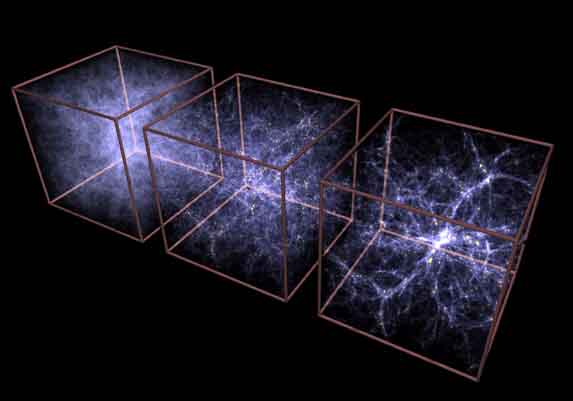
Dark Energy should not to be confused with Dark Matter or Dark Fluid.
In astronomy and cosmology Dark Matter is matter that is inferred to exist from gravitational effects on visible matter and background radiation, but is undetectable by emitted or scattered electromagnetic radiation.
Dark Fluid is an alternative theory to both Dark Matter and Dark Energy that attempts to explain both phenomena in a single framework. It proposes that dark matter and dark energy are not separate physical phenomena as previously thought, nor do they have separate origins, but that they are linked together and are really specific sub-effects of new extended laws of gravity at very large scales.
While dark energy repels, dark matter attracts. Dark energy shows itself only on the largest cosmic scale, while dark matter exerts its influence on individual galaxies as well as the universe at large. About one-quarter of the universe consists of dark matter, which releases no detectable energy, but which exerts a gravitational pull on all the visible matter in the universe.
In physical cosmology, astronomy and celestial mechanics, dark energy was a hypothetical and allegedly confirmed form of energy that permeates all of space and tends to increase the rate of expansion of the universe. Dark energy is the most accepted theory to explain recent observations and experiments that the universe appears to be expanding at an accelerating rate. In the standard model of cosmology, dark energy currently accounts for 73% of the total mass-energy of the universe.
Two proposed forms for dark energy are the cosmological constant, originally proposed by Albert Einstein as a modification of his original theory of general relativity to achieve a stationary universe. Einstein abandoned the concept after the observation of the Hubble redshift indicated that the universe might not be stationary, as he had based his theory on the idea that the universe is unchanging. However, a number of observations including the discovery of cosmic acceleration in 1998 have revived the cosmological constant, and the current standard model of cosmology includes this term.
Researcher finds hint of dark energy discussion in letters between Einstein and Schrodinger PhysOrg - December 11, 2012
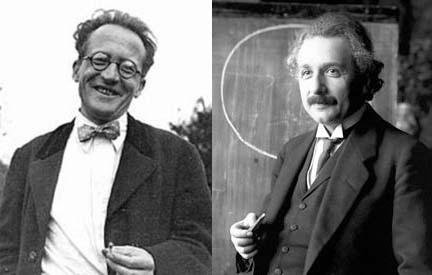
Alex Harvey, a physics professor at the City University of New York has uploaded a paper in which he claims Albert Einstein and Erwin Schrodinger were writing letters suggesting the two men were on the precipice of discussing the possibility of the existence of dark energy. The letter exchange came in the years after Einstein had published his theories on general relativity, and revolved around the matter of the cosmological constant.
The first direct evidence for dark matter was discovered while studying the outer regions of the Milky Way Galaxy.
The first direct evidence for dark energy came from supernova observations of accelerated expansion, in Riess et al. and later confirmed in Perlmutter et al. This resulted in the Lambda - CDM model, which as of 2006 is consistent with a series of increasingly rigorous cosmological observations, the latest being the 2005 Supernova Legacy Survey. First results from the SNLS reveal that the average behavior (i.e., equation of state) of dark energy behaves like Einstein's cosmological constant to a precision of 10%. Recent results from the Hubble Space Telescope Higher-Z Team indicate that dark energy has been present for at least 9 billion years and during the period preceding cosmic acceleration.
The term dark energy, echoing Fritz Zwicky's dark matter from the 1930s, was coined by Michael Turner in 1998. By that time, the missing mass problem of big bang nucleosynthesis and large scale structure was established, and some cosmologists had started to theorize that there was an additional component to our universe.
In the 1970s Alan Guth proposed that a negative pressure field, similar in concept to dark energy, could drive cosmic inflation in the very early universe. Inflation postulates that some repulsive force, qualitatively similar to dark energy, resulted in an enormous and exponential expansion of the universe slightly after the Big Bang. Such expansion is an essential feature of most current models of the Big Bang. However, inflation must have occurred at a much higher energy density than the dark energy we observe today and is thought to have completely ended when the universe was just a fraction of a second old. It is unclear what relation, if any, exists between dark energy and inflation. Even after inflationary models became accepted, the cosmological constant was thought to be irrelevant to the current universe.
In the News ...
Scientists use quasars to probe dark energy over 10 billion years in the past PhysOrg - November 13, 2012
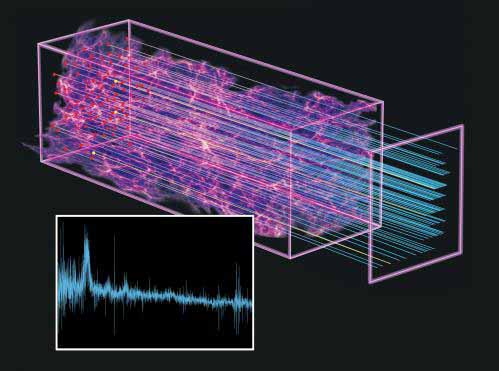
BOSS, the Baryon Oscillation Spectroscopic Survey, is mapping a huge volume of space to measure the role of dark energy in the evolution of the universe. BOSS is the largest program of the third Sloan Digital Sky Survey (SDSS-III) and has just announced the first major result of a new mapping technique, based on the spectra of over 48,000 quasars with redshifts up to 3.5, meaning that light left these active galaxies up to 11.5 billion years in the past.
Dark energy is real, say astronomers PhysOrg - September 12, 2012
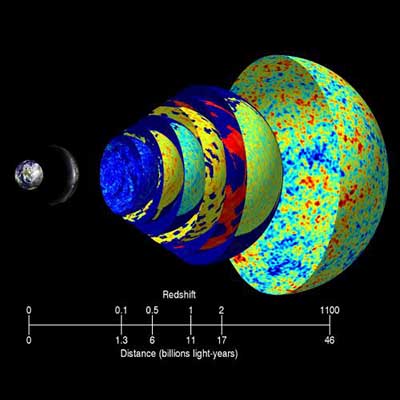
Dark energy, a mysterious substance thought to be speeding up the expansion of the Universe is really there, according to a team of astronomers at the University of Portsmouth and LMU University Munich. After a two-year study led by Tommaso Giannantonio and Robert Crittenden, the scientists conclude that the likelihood of its existence stands at 99.996 per cent.
Dark Energy, Dark Matter NASA - April 2012
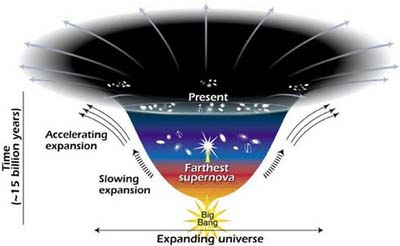
We know how much dark energy there is because we know how it affects the Universe's expansion. Other than that, it is a complete mystery. But it is an important mystery. It turns out that roughly 70% of the Universe is dark energy. Dark matter makes up about 25%. The rest - everything on Earth, everything ever observed with all of our instruments, all normal matter - adds up to less than 5% of the Universe. Come to think of it, maybe it shouldn't be called "normal" matter at all, since it is such a small fraction of the Universe.
Is Dark Energy Really "Repulsive Gravity"? National Geographic - February 16, 2012
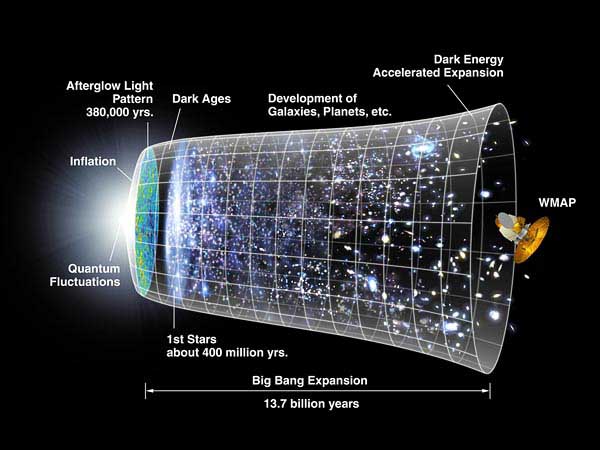
A powerful repulsion between normal matter and hidden pockets of antimatter could be an alternate explanation for the mysterious force known as dark energy, according to a controversial new theory. In 1998 scientists discovered that the universe is not only expanding but that its expansion is accelerating. This totally unexpected behavior has been called the "most profound problem" in physics, because our current understanding of gravity says that attractions between mass in the universe should be causing the expansion to slow down.
Galaxy Evolution Explorer finds dark energy repulsive PhysOrg - May 20, 2011
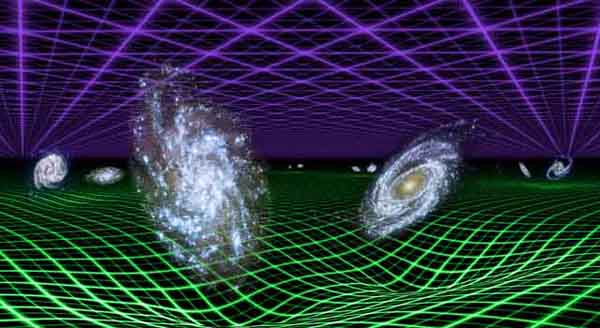
New results from NASA's Galaxy Evolution Explorer and the Anglo-Australian Telescope atop Siding Spring Mountain in Australia confirm that dark energy (represented by purple grid) is a smooth, uniform force that now dominates over the effects of gravity (green grid). The observations follow from careful measurements of the separations between pairs of galaxies (examples of such pairs are illustrated in the image above). The five-year survey of 200,000 galaxies, stretching back seven billion years in cosmic time, has led to one of the best independent confirmations that dark energy is driving our universe apart at accelerating speeds.
Dark Energy vs. The Void: What if Copernicus was Wrong? PhysOrg - September 26, 2008
Dark energy is at the heart of one of the greatest mysteries of modern physics, but it may be nothing more than an illusion. The problem facing astrophysicists is that they have to explain why the universe appears to be expanding at an ever increasing rate. The most popular explanation is that some sort of force is pushing the accelerating the universe's expansion. That force is generally attributed to a mysterious dark energy. Copernicus was among the first scientists to argue that we're not in a special place in the universe, and that any theory that suggests that we're special is most likely wrong. The principle led directly to the replacement of the Earth-centered concept of the solar system with the more elegant sun-centered model.
 Dark Energy: The Movie Hubble Website - December 7, 2007
Dark Energy: The Movie Hubble Website - December 7, 2007
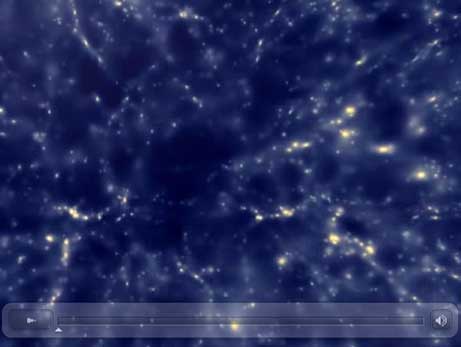
The universe we can see ... the universe we can touch ... is only a tiny fraction of the universe that exists.
Mysterious Dark Energy Has Existed For Most of Time, Scientists Say National Geographic - November 17, 2006
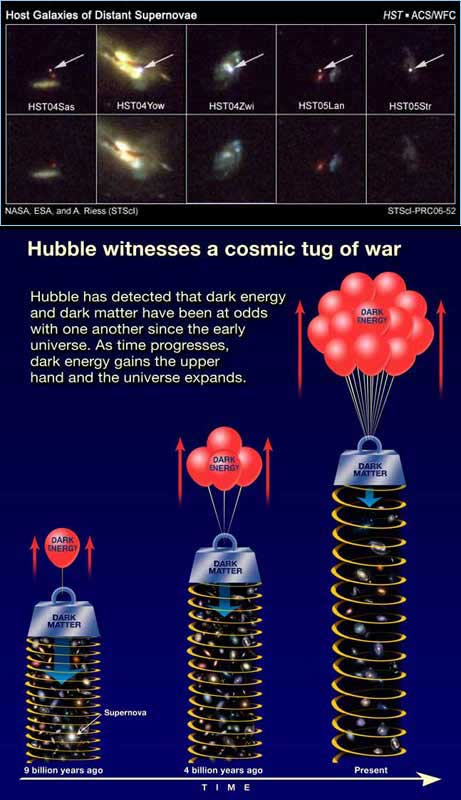
Peeling back both space and time, scientists using the Hubble Space Telescope have found that the strange force known as dark energy appears to have existed for at least the past two-thirds of the universe's history. Dark energy is a mysterious repulsive force that opposes gravity, causing the universe to expand. Albert Einstein posited that a form of the force existed nearly a century ago by, but it was not discovered until 1998.